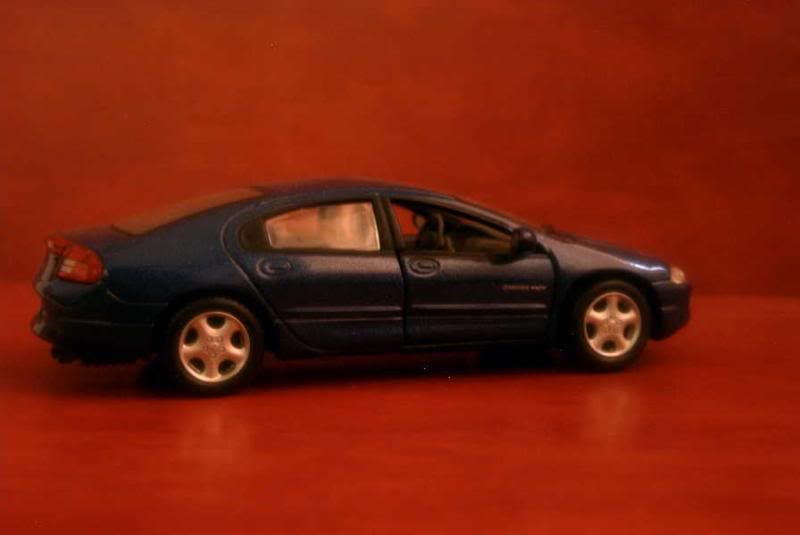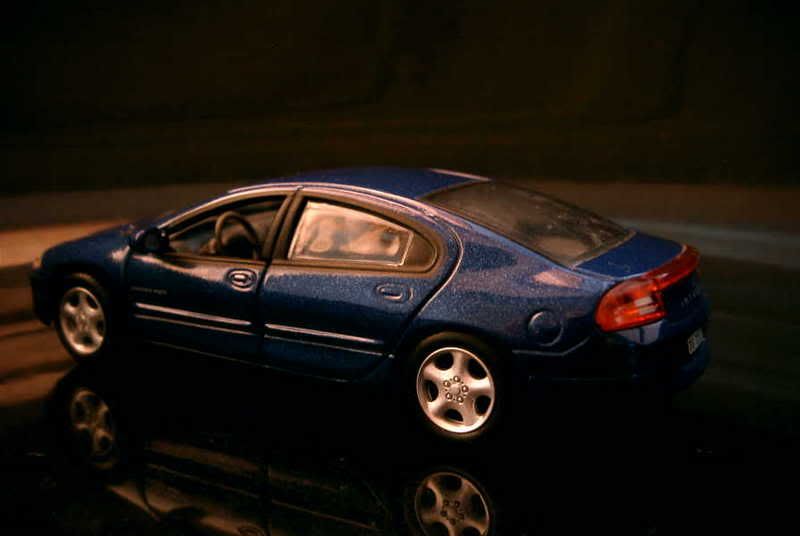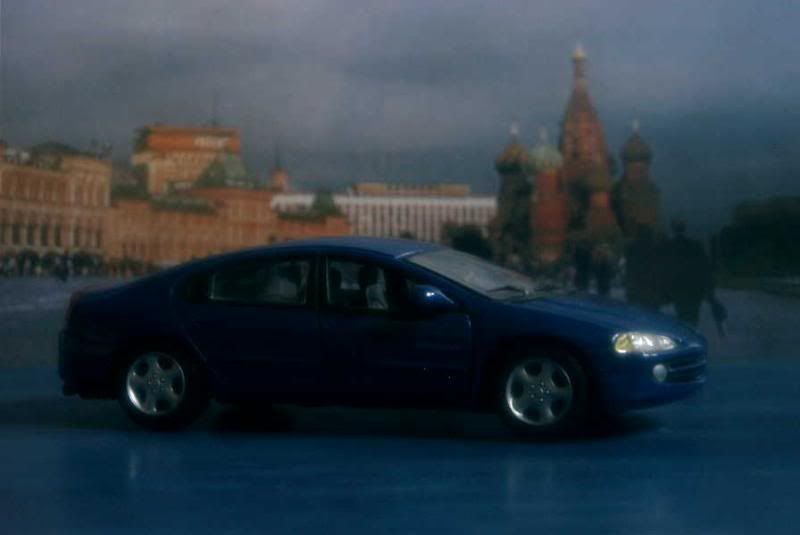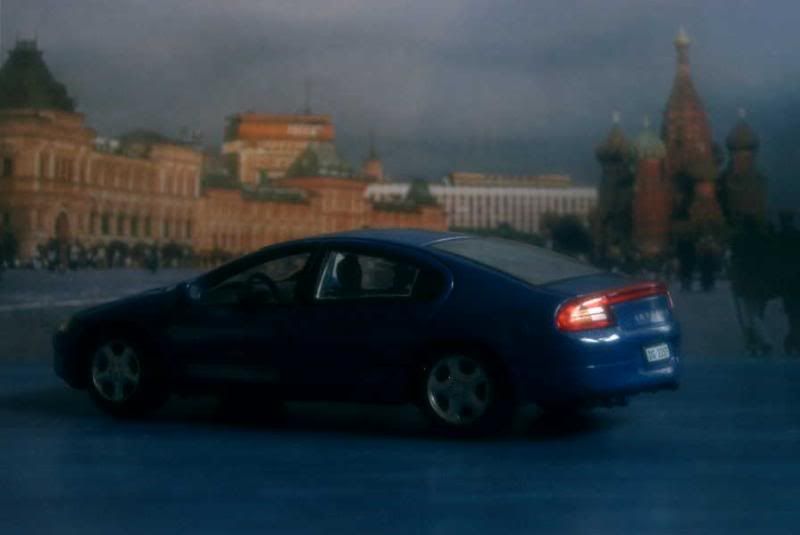A little history
Around 1990, it seems that Chrysler was heading straight to bankruptcy. Timely introduced, a radically new design would pull the company out of trouble – at least for a few more years: the Chrysler LH.
LH was the generic name for the platform Chrysler studied in order to replace its various upper mid-range sedans of the late Eighties. Oddly enough, Chrysler drew a lot from the ill-fated Eagle Premier and Dodge Monaco, unfortunate cars that had been inherited from the AMC takeover. Based on a Renault 21 chassis, but borrowing many mechanical parts and a few body elements, such as the doors, from the Renault 25, the Premier and Monaco’s careers ended in utter failure. Nevertheless, Chrysler found this base was reasonably modern to be used as a starting point for the LH, which most notably carried over its uncommon front-wheel-drive, longitudinal engine combination. A more noticeable particularity of the LH was its so-called “cab-forward” design, with its four wheels pushed to the corners of the car, allowing for good handling and spacious passenger compartment. Along with its modern appearance, the cab-forward design would be one of the main selling points of the LH.
The LH was launched in 1993. The range included the Chrysler Concorde, the Eagle Vision and the Dodge Intrepid. A Plymouth Accolade was considered and almost made it to the market, but the low-end company within the Chrysler group was already doomed, and the rebadging scheme was ultimately cancelled. On the other hand, two other models joined the initial three in 1994: the Chrysler New Yorker, aimed at slightly older, more conservative customers, and the Chrysler LHS, which offered a blend of luxury and performance which positioned it as a cheaper alternative to European imports, most notably German ones. All cars received V6 engines of 3.3- and 3.5-litre displacements, while transmission was solely through an automatic gearbox.
Without any true rival among the rest of the American automobile industry, the Chrysler LH soon cut itself an enviable share of the domestic market. Better still: it proved an influential car that showed the way to how American automobiles of the future should be designed. By 1997, competition had learned and was gaining fast on Chrysler, which nonetheless was resolute in staying ahead with a likewise admirable second-generation LH. Though the chassis was left unchanged for the most part, the new LH pushed even further the cab-forward concept, receiving a short, sloppy bonnet almost in line with its impressively large windshield, and an equally short boot. Released for the 1997 model year, the second LH was either built as a Chrysler LHS, a Chrysler Concorde or a Dodge Intrepid. Already dropped from the line by then, the old New Yorker name was nothing more than a piece of Chrysler’s patrimony. The Eagle brand being discontinued, there were no second-generation Vision, though an aborted project for such a car appeared one year later as the Chrysler 300M. This second LH was built with constant success until 2004 when, though still an advanced design by then, it was replaced by a rear-wheel-drive vehicle, the LX – see how surprising automobile history can sometimes be…
About the model
Model: Dodge Intrepid R/T
Year: c.2000
Maker: Hongwell
Scale: 1/43
Distributed by: Cararama
Acquired: second hand with neither stand nor box, in January 2007, in Shenzhen, China
That it is a Cararama, and not among the most recent ones, means that Minichamps-like quality isn’t in order. Nevertheless this die-cast, positioned half-way between collectibles and toys, still does the trick on a collector’s shelf. True, most details could have been done better, but nothing’s really botched. Furthermore, Cararama’s LH doesn’t have many rivals (who else cares about such a car?), and its price is among the lowest you can find. I’ll give 10/20 to it.






Around 1990, it seems that Chrysler was heading straight to bankruptcy. Timely introduced, a radically new design would pull the company out of trouble – at least for a few more years: the Chrysler LH.
LH was the generic name for the platform Chrysler studied in order to replace its various upper mid-range sedans of the late Eighties. Oddly enough, Chrysler drew a lot from the ill-fated Eagle Premier and Dodge Monaco, unfortunate cars that had been inherited from the AMC takeover. Based on a Renault 21 chassis, but borrowing many mechanical parts and a few body elements, such as the doors, from the Renault 25, the Premier and Monaco’s careers ended in utter failure. Nevertheless, Chrysler found this base was reasonably modern to be used as a starting point for the LH, which most notably carried over its uncommon front-wheel-drive, longitudinal engine combination. A more noticeable particularity of the LH was its so-called “cab-forward” design, with its four wheels pushed to the corners of the car, allowing for good handling and spacious passenger compartment. Along with its modern appearance, the cab-forward design would be one of the main selling points of the LH.
The LH was launched in 1993. The range included the Chrysler Concorde, the Eagle Vision and the Dodge Intrepid. A Plymouth Accolade was considered and almost made it to the market, but the low-end company within the Chrysler group was already doomed, and the rebadging scheme was ultimately cancelled. On the other hand, two other models joined the initial three in 1994: the Chrysler New Yorker, aimed at slightly older, more conservative customers, and the Chrysler LHS, which offered a blend of luxury and performance which positioned it as a cheaper alternative to European imports, most notably German ones. All cars received V6 engines of 3.3- and 3.5-litre displacements, while transmission was solely through an automatic gearbox.
Without any true rival among the rest of the American automobile industry, the Chrysler LH soon cut itself an enviable share of the domestic market. Better still: it proved an influential car that showed the way to how American automobiles of the future should be designed. By 1997, competition had learned and was gaining fast on Chrysler, which nonetheless was resolute in staying ahead with a likewise admirable second-generation LH. Though the chassis was left unchanged for the most part, the new LH pushed even further the cab-forward concept, receiving a short, sloppy bonnet almost in line with its impressively large windshield, and an equally short boot. Released for the 1997 model year, the second LH was either built as a Chrysler LHS, a Chrysler Concorde or a Dodge Intrepid. Already dropped from the line by then, the old New Yorker name was nothing more than a piece of Chrysler’s patrimony. The Eagle brand being discontinued, there were no second-generation Vision, though an aborted project for such a car appeared one year later as the Chrysler 300M. This second LH was built with constant success until 2004 when, though still an advanced design by then, it was replaced by a rear-wheel-drive vehicle, the LX – see how surprising automobile history can sometimes be…
About the model
Model: Dodge Intrepid R/T
Year: c.2000
Maker: Hongwell
Scale: 1/43
Distributed by: Cararama
Acquired: second hand with neither stand nor box, in January 2007, in Shenzhen, China
That it is a Cararama, and not among the most recent ones, means that Minichamps-like quality isn’t in order. Nevertheless this die-cast, positioned half-way between collectibles and toys, still does the trick on a collector’s shelf. True, most details could have been done better, but nothing’s really botched. Furthermore, Cararama’s LH doesn’t have many rivals (who else cares about such a car?), and its price is among the lowest you can find. I’ll give 10/20 to it.









3 comments:
I know this post is old, but if you still have the model, would you mind taking a few pictures of the bottom of this Intrepid model? I'm an avid fan and supporter of the Intrepid but can't find any good pictures of the undercarriage.
If it's detailed, I would like to use it as a reference for an art project I'm working on.
If you know where I can purchase a scale model of the Intrepid, please let me know. I've been looking for a while.
I appreciate the help!
Hi Kevin,
No problem, except that most of my models are now packed in cartons rather than on their shelves, so it may take some time before I succeed in locating this model. Just be patient, I promise that I'll get a few pictures for you! :)
About the model, it's made by Cararama, which is quite a common brand, and a cheap one with that. I suppose that it's distributed in most parts of the world, but if you have problems finding one where you reside, e-bay is probably a good choice. Before this, try to check the toy section of large stores, not exclusively hobby stores, though they may have some of them too. The price may vary but I bet you won't pay much more than the equivalent of 7 or 8 USD if you find one.
Regards,
Lorenzo.
Well, this model is still nowhere to be found as of now.
Post a Comment